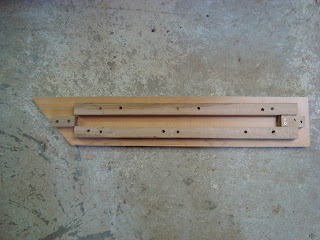 |
| Shaker table, by Rolf Sonnerup, oceanographer, salmon fisherman and woodworker. |
Here's a close-up of one of Rolf's legs, turned sideways. You can see that the bottom edge is straight, whereas the top edge is slanted:
Jack, my woodworking teacher, suggested making a jig, which is a template or guide, so that all eight legs could be planed to the desired angle at the same time.
Here is what the finished jig, made out of scrap wood, looks like:
 |
| Bird's eye view of the jig. The leg will fit in the space in the middle. |
The jig is made to the exact dimensions of one squared, planed leg so that it fits snugly in the space in the middle. Now the jig is loaded:
 |
| Jig with squared, planed leg in middle. |
The key is to elevate the leg at one end by having it sit on a small block of wood:
 |
| Close-up of jig. One end of the leg sits elevated on the tiny ledge to the left of the two screws. |
You can see this difference in elevation clearly in a side view of the loaded jig:
 |
| The leg (lighter wood) is elevated to the right. The loaded jig is sitting on top of the thickness planer machine. |
The loaded jig is then put into the thickness planer machine, which has an overhead rotating blade that will slice off thin layers of wood from the top. Because the leg is elevated at only one end, the planer preferentially cuts off wood at only that end. This results in a tapered leg with one slanted surface. The bottom surface stays straight.


That is so cool! I have always wanted to be able to do some woodworking. To create a beautiful piece of furniture out of lumber seems an extraordinary thing. Can't wait to see how this turns out!
ReplyDeleteWhile you may be able to profit from providing utilities to your tenants, you may also be losing money. how-to-start-a-woodworking-business.s3.amazonaws.com
ReplyDelete